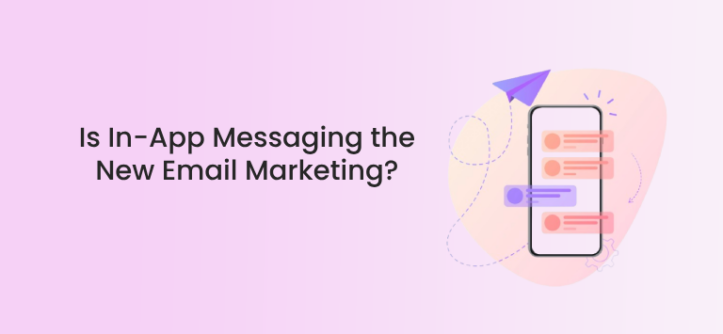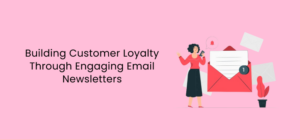Emails are an effective and affordable way to engage new and existing customers. Brands worldwide leverage it to build and manage their contact database, personalize their targeting, gather data on their audience, and more. But consumer behavior is constantly changing. Nowadays, consumers spend most of their online time using mobile apps and marketers need to adapt their messaging to this rising need:

(Source – financesonline.com)
In-app messaging is a new form of marketing that enables marketers and business owners to increase sales while enhancing customer loyalty. It’s about personalizing user experience in real-time and offering direct communication. It’s cost-effective, too. Rings a bell, right? These characteristics have resulted in marketing professionals comparing in-app messages to emails.
In this guide, we will discuss what in-app messaging is, along with its benefits, limitations, and best practices. Also, we will answer the lingering question: is it the new email marketing?
What Is In-App Messaging?
In-app messaging refers to delivering messages to users while they interact with your mobile application. It’s a real-time, direct, and laser-focused method for brands to engage with app users at different times throughout the customer journey. From incorporating in-app messages in your onboarding to making them part of your customer experience strategy, they go beyond marketing your products or services. Continue reading to learn more about the benefits of using in-app messages in your business strategy.
Why Should You Use In-App Messages?
In-app messaging comes with several benefits, business and customer-wise. Let’s get started:
They increase user engagement
With in-app messaging, you reach users where they are: inside your mobile app. This type of message is displayed while the user navigates through your app, making it easier for you to grab their attention. Consumers are more likely to engage with your brand through your app than an external method like a social media post. So, use your in-app messaging to establish two-way communication and encourage users to take advantage of every functionality of your app.
You contact users at the right time
With external marketing messages, no one guarantees you will reach consumers at the best time possible. For instance, using robust email automation software lets you schedule the delivery of your email campaign, but still, you have no way of knowing when the user will actually open it. With in-app messages, you can set them up to appear in certain places and to specific groups, which in turn helps you reach all users at the right time and place.
They drive more conversions
The power of in-app messaging lies in the fact that it motivates them to take action right then and there. For the sake of example, let’s imagine you send such a message to announce a new feature. The user has the ability to test it right then and there based on your instructions. Sending laser-focused messages when users engage with your app prompts them to make the most out of its usage. Therefore, they are more likely to act on your message and convert.
You target different segments with personalized messages
Your users have different profiles, preferences, and needs. What’s more, their in-app behavior and their stage within the customer lifecycle varies. So, it’s essential to tailor your communication to give them a personalized experience. In-app messages are easily customizable, so you can adjust them to fit user-profiles and make them look as if you created them specifically for each consumer. For instance, you could leverage in-app messages as part of your customer loyalty program to reward loyal customers.

(Source – smartinsights.com)
What Are the Limitations of In-App Messages?
We listed the benefits that come with in-app messages. But what about their limitations? As with every method, there are things to take into consideration when leveraging in-app messages. Here are the most crucial challenges you may face:
You mostly contact engaged users
By their nature, in-app messages mostly reach engaged users since they have to be active in the app to spot your messages. As a consequence, they probably aren’t a great option for reengaging inactive users. This is why it becomes all the more important to impress new users right from the first point of contact with your product and prompt them to stay active.
They may not serve every marketing objective
Due to their urgent and timely nature, in-app messages are best suited for specific objectives, such as announcing a flash sale to drive conversions. But let’s say you have an upcoming webinar on how to sell on Facebook marketplace, and you want to build brand awareness through it. In that case, perhaps email marketing or social media are the most suitable channels to tell your prospects about it.
They are subject to brevity rules
People are accustomed to consuming large blocks of text within an email marketing campaign. Emails may feature long-form content, depending on the occasion. But in-app messages come with character limitations. Not to mention your audience expects this type of communication to be short and to the point while delivering timely content. So, including unnecessary information in this type of messaging is a recipe for disaster.
They can get annoying
When you do in-app messaging wrong, it could bring the opposite results and annoy users. Sending too many messages or not knowing when the right moment is may result in user fatigue. Overwhelmed consumers have all the reasons in the world to stop interacting with your product, so ensure you perform A/B testing regularly to figure out what best resonates with your target audience.

(Source-mindsea.com)
5 In-App Messaging Best Practices to Drive User Engagement
We’ve covered what in-app messaging offers your business and the limitations that come along. Now it’s time to catch up on the best practices to create messages that drive user engagement.
- Create short, clear, and concise copy
In-app messaging is all about clear and concise communication. Your message has to be short and straightforward so that users can easily grasp key information. Using plain language and accurate phrasing will help you communicate your message and direct users to act on it. Avoid technical jargon and unnecessary details to cut down on potential frustration.
Always ensure you’re meaningful in what you say to catch users’ attention without overwhelming or annoying them. Invest in copy that gets to the point as quickly and effectively as possible, and keep things simple, thus letting consumers focus on your call to action.
- Define your audience
We can’t talk about personalized in-app experiences without defining a company’s target audience first. Different audience groups have different objectives and display different behaviors when using your product. To provide all of them with personalized marketing material, you need to segment your audience according to several criteria, like their demographics, needs, and pain points.
Use the data you gathered during the signup process to customize their in-app experience. If you find them to be insufficient, consider requesting further information from new and existing customers. Then, you will be on your way to delivering messages that are specifically tailored to each user segment according to the criteria you’ve set.

The importance of creating buyer personas (Source-clockwise.software)
- Add value to their experience
It might seem like stating the obvious, but every in-app message you send should add to your users’ experience. When creating in-app messages, first, you should think about how it’s going to help the user. Whether it’s about addressing a specific challenge or getting them from point A to point B, your main objective is to offer value throughout their journey.
In-app messaging should be centered around your value proposition and call to action without explaining everything about your product update or new feature. Users appreciate brands cutting to the chase, so highlight what’s in it for them quickly and at a time that your message will facilitate engagement.
- Optimize your call to action
No matter the effort you’ve put into your in-app messaging, it will do you no good if you don’t have a visible, actionable, and attention-grabbing call to action. A poorly designed or disruptive CTA could make or break your campaign. After all, it’s the element that invites users to perform a specific action.
So, before anything, its phrasing should be as clear as possible to help them understand what you want them to do next. Leverage bold colors and place your CTA prominently so no user misses it without disrupting their in-app experience either. Also, it’s preferable to go with a single CTA since multiple CTAs are likely to frustrate your customers and prevent them from converting.
- Leverage them for user feedback
In-app messages aren’t limited to notifying users about sales, offers, product launches, or new features. They’re also an effective way to gather important customer feedback. Chances are your users will be more willing to answer an in-app survey compared to one included in an email campaign. Collecting this type of data not only helps you optimize your messages but make customers think of you as a customer-centric brand that values their input.
There’s also the option of using NPS (Net Promoter Score) surveys to find out your users’ level of satisfaction with your product. You can take it as far as asking them to explain why they selected a particular score within the scale you’ve set. This lets you determine which aspects of your app users are excited about, as well as which of them affect user experience negatively. Or, you could try out a rating system where users rate your app based on their experience. Then, you get to make better decisions based on their ratings. What’s more, positive reviews might help with customer acquisition since they increase the credibility of your app.

(Source- fastercapital.com)
The Verdict: Are In-App Messages the New Emails?
Without a doubt, in-app messages are the talk of the town. They are engaging and hard to ignore, which makes them a bulletproof way to impact user behavior and drive conversions. Emails, on the other hand, have been around for long enough to prove their importance in any brand’s overall marketing strategy. There are many things that the two channels have in common, from delivering personalized experiences to collecting valuable feedback.
But marketers and business owners need to understand that they serve different purposes and occasions. For example, an email is best suited to re-engage inactive customers through valuable long-form content, like industry tips and case studies or educational material, like videos and FAQs. But if you have important updates or announcements coming up, in-app messages are probably a better option to tell active users all about it. Why? Because you have the chance to engage them right then and there with relevant content that they are unlikely to ignore.
So, we’ll have to say the verdict is no. Email marketing is definitely not dead and in-app messaging won’t replace it. In-app messages and emails differ in many aspects. They do have something in common, though: they are indispensable tools for marketers looking after business growth. This is why they should use them in a complementary way to build stronger connections with their target audience and turn them into loyal customers.
Author’s Bio:
Maria Fintanidou works as a copywriter for email marketing automation software Moosend, having created the Help Articles (FAQs) and overseen the platform’s translations in Greek and Spanish. She loves exploring new cultures and ways of thinking through traveling, reading, and language learning.




